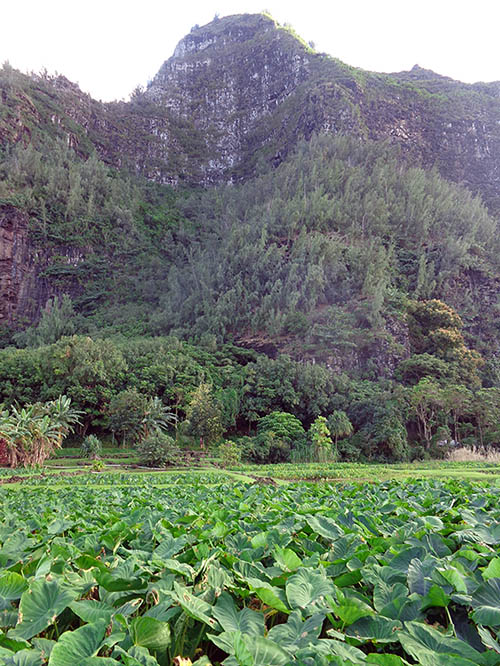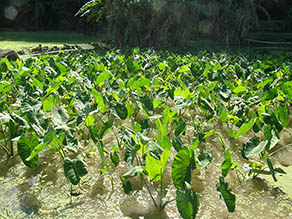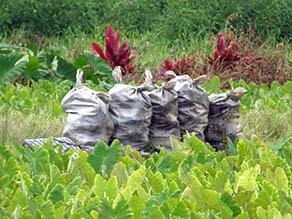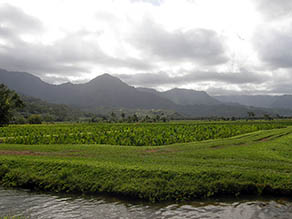 |
 |
 |
 |
||||||
|
|
|
|
|
|
|
|
|
|
 |
|
 |
|||||||
 |

Taro lo‘i at the base of Makana mountain.
|
 |
|
 |
The lower portions of Limahuli Valley, and the short slopes of Mānoa Valley, were laced with wet-pond terraces (lo‘i) used to grow taro. Over the last century, as populations dwindled and modes of production changed, much of this agricultural land fell into disuse. But that it once supported a flourishing and important community is certain. “Only a small fraction of the lo‘i are evident here,” Carlos points out, gesturing at the taro pondfields that have been brought back into production. “All of this area now included in the park used to be lo‘i, all the way down into that loko [pond] adjacent to Waikanaloa Cave and the present highway. There’s lo‘i everywhere. They bulldozed this road right through fields of lo‘i, in the forties or fifties, to create the highway. The traditional road ran near the sea behind the sand dunes. There was a wagon road that went all the way to where the ocean comes close, where the Wichman’s house is. I don’t know what year the county built this road, but they bulldozed all through lo‘i to get to the end of the road.”
“There were several houses back in there that I used to come to before, and most of the families that had taro patches here, their houses were on the other side of the stream, further over. But there were people that had houses on the ocean side. There is no lo‘i there, it’s just sand dunes and they had their houses over there. “Thomas Hashimoto grew taro on this side, and the Maka family grew taro on that side. And there were other people as well. I’m not familiar with all the people, but I remember coming down and staying. There was a house across on the other side of the drainage canal. Big yard. The poi mill was over here, a small one. The remnants are still there. Concrete foundation is still there.” “When I was four years old, we used to farm right up here for home use,” Uncle Tom recalls, sitting amidst the recently-restored lo‘i. “The patches were convenient for my folks, because it was smaller, not the big ones, so they could handle it. Because everything was, you do your thing with tools that you put together. At the time you cannot go to the store and go buy it. Old time, you improvise, even myself. No machine for go inside there. Like no more power saw for cut the tree. You get the hand saw. Hand saw, cane knife, axe. For working on this thing here, cane knife, axe, pick, shovel. All the kine stuff that I get, what I used to go do all that. Did all these patches over here by hand, me and my wife. Because my earning was not enough. “At the time I was making only $58 dollars to raise my family. This was way back in 1950, and I was married in 1954. I was young, 19, trying to make life work for myself and try not to bother my Dad, but can assist him in every way I could. Because my two brothers were in the Korean War. They were away so I stayed. I joined the National Guard in 1950, so I was still home and assisted him in any way I can, which I did for most of his life. You know, do this, do that, and at the same time, he was filling me with all this good stuff. And today I’m utilizing it, and passing it on to my people. “Before, when they go plant, the moon got to be so and so and all of that. So what they used to do, I would say pile up the huli, put them all in the mud, in water. You cut the leaf off, you cut the leaf off and you put them put them all what place you’re planting. You leave them there—and then they wait for the moon. The Mahealani moon or whatever. They know the moon for what depth of the plant and when they plant they plant, they plant all the whole thing. But not today, they don’t follow there, they just plant because make, you know—for home use. But that’s the old people used to do. And that’s a different kind of growing taro. “And at that time, no more fertilizer, they use all organic. Like the rubbish layer—we used to do that. Then you turn the soil just like how you make the humus. These people, they do their own, all that stuff. They throw them over there, let them all rot and stuff like that, and then dig them, dig them until the worm rots them all off. And then they go take them to the garden, and plant their vegetables. And just like fertilizer. They make their own organic. We used to do that in the past. We didn’t always stick to the old style, but our folks wen tell us, would show us da kine of stuff. “Now we like go on the quick action, like fertilization is fast. Look at this, you look at this right here: its fertilizer. Chemical. That’s why you see the taro patches all green. This one right here, all these are introduced to fertilizer. That’s why you see them green like that, to make them grow. But before, you use organic. Because in the early days there was no fertilizer and you kind of make your own, that’s how it was. And that rubbish layer, we go in there with a hoe, grind them all up into there, the leafs, shoot ʻem all inside the taro patch. And then you go into there, you turn them over, turn them over, just like how you making the kind of organic kind of fertilizer. You turn them over, turn them over, until no more the steam. Like in the water, no more the bubbles. The bubbles all die out. It’s when you know, and then you look, a little grass starts to grow, you know it's ready. And that’s how it was, the old times.” Read about agriculture in Mānoa valley. “Of course every home had a garden,” Nalani states. “The old folks that were living, everybody had a garden, and they just grew basic stuff that they ate. Back then we didn’t have the variety of lettuce that we had, the only lettuce that I remember my grandparents growing was the Manoa lettuce, sweet potato, cucumbers, tomato, Kai Choy, green head cabbage, a lot of chili pepper, eggplant, beans—green beans, string beans. "Back then they had the leaf onions, but it had the purple head and they always called it Hawaiian onion because it had a purple bulb, but it had the green leaf, besides the regular onion that has a white tip. Basic things like that, that they utilized cooking. That’s what you had.” “Everybody grew a garden in their yard,” Michael agrees. “Everybody had a nice garden, growing everything you can eat. Nowadays, they plant this nice leaf, but you cannot eat nothing from there. That’s not edible. Back then, they grew what was edible before. I liked it, because you could go your auntie’s house and we’ll grab two cucumbers out of the garden, even if they’re not home. You don’t have to ask. But it was okay to take only what you need, and vice versa, they could do the same with you. We grew a lot of vegetables in our yard. Lahela says, “We have a farm, maybe more than four acres, up in Wainiha Valley, and my parents still have it. It’s been a struggle for us to try to keep it with the young generation, for our nieces and nephews and even for our kids. It actually takes more than just one person to farm and so we are struggling at our age for keep that going. I was totally raised in farming, we were growing our own taro. It was to help us for some money, but the majority was for help the families."
|
 |
 |
|
|
 |
 |
“I used to really be so mad because we were so young, but we always to pull the taro. We had to harvest a whole lot, and we had to do it at a young age. Now I am grateful to my parents, but at the time, when you’re young, you don’t appreciate. You just think it’s hard work. But there is more mana‘o behind that: it’s the family, you’re working together, trying to work together. It will make you have to work together when you farm and such, so we would have to make like hundreds of pounds of poi. As I grew up, it was like ‘What are we doing, what? We have to pull some more bags?’ But I think that’s why we were successful in our farming, because it was not just only for money. My Dad worked for the County and that was what we did once a week. Five bags, ten bags, we had to pull.” “Taro farming in Hawai‘i has become driven so much by commercial farming that subsistence farming is something that isn’t practiced so much anymore,” Kawika explains. “It’s kind of the minority of practices, subsistence farming, most of it’s commercial. And so now as people are getting re-interested in taro farming and trying to re-engage, the only traditions that they see are commercial farming traditions. "And basically the major difference is we harvest everything all at once. Going to be economy of scale, you get everything off to the market in a bulk shipping rate so you get more money for your taro. "But subsistence farming, if you harvested your whole patch all at once, you’d have more food and most of it would rot and then you’d starve the rest of the time. So with subsistence farming is know how to plant—both the diversity and stages of your patch, such that you can always harvest food. “You manage your series of patches, your planting cycle, so that you have food year around, not harvest one patch all at once and send it off to market. Which is a completely different mindset, so it’s a little bit challenging for people to wrap their brains around that, something we’re trying to be a living example of. So if people want to know how, they can come here and see all that.”
|
 |
 |
Planting is not the only method by which sustenance is derived from the land. Gathering of various sorts from the forests also provides important food sources.
|
 |
||
 |
|
 |
||

|
|
||||
| Copyright 2018 Pacific Worlds & Associates • Usage Policy • Webmaster |
||||












